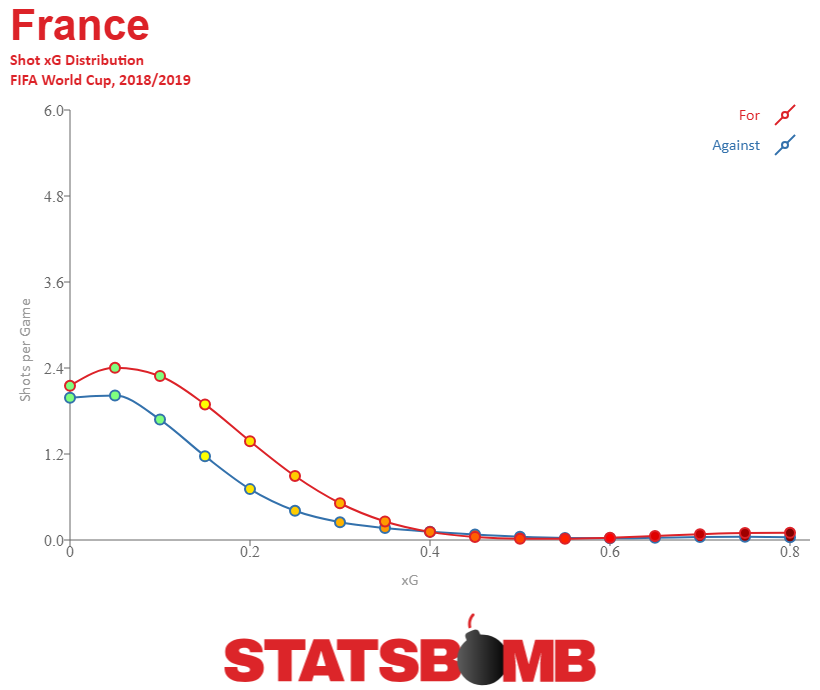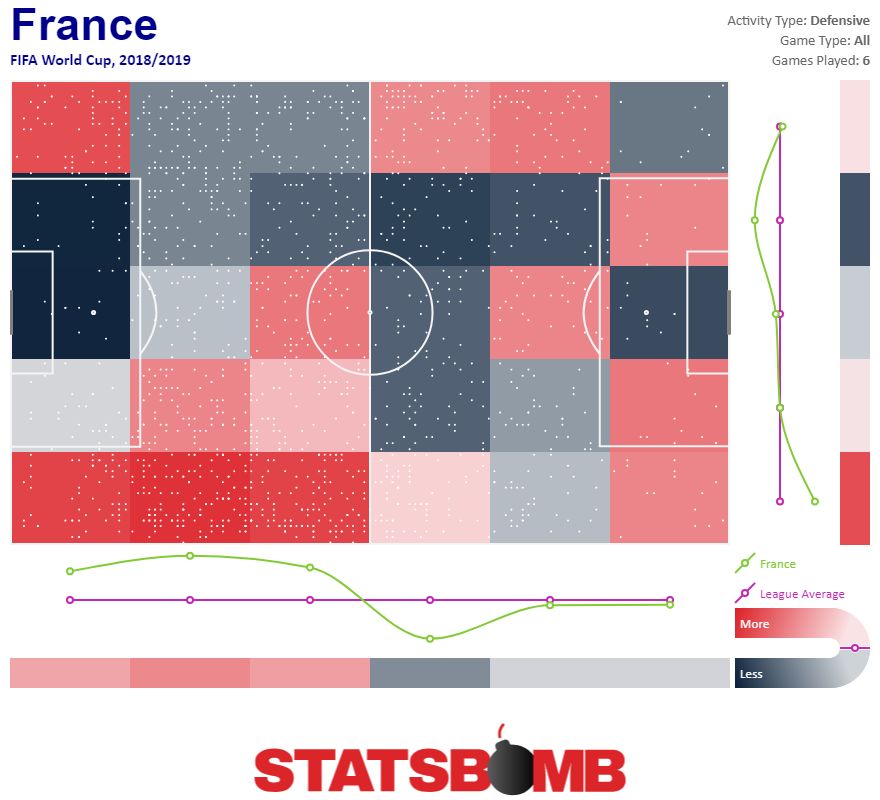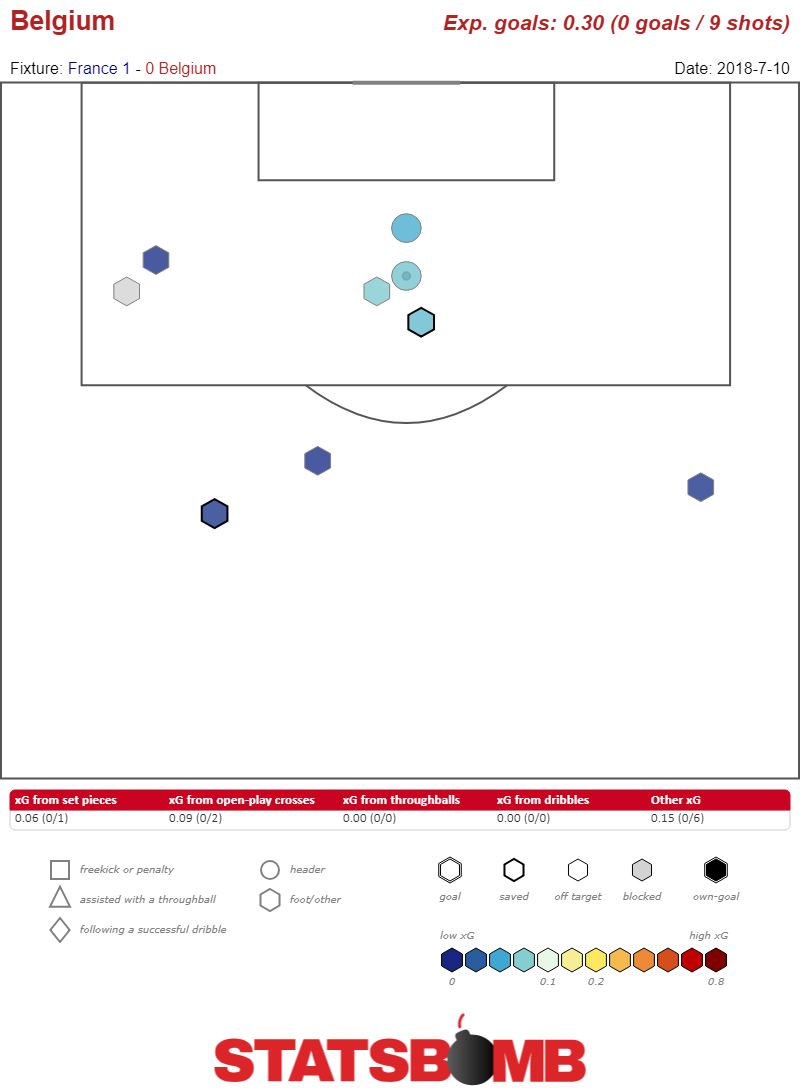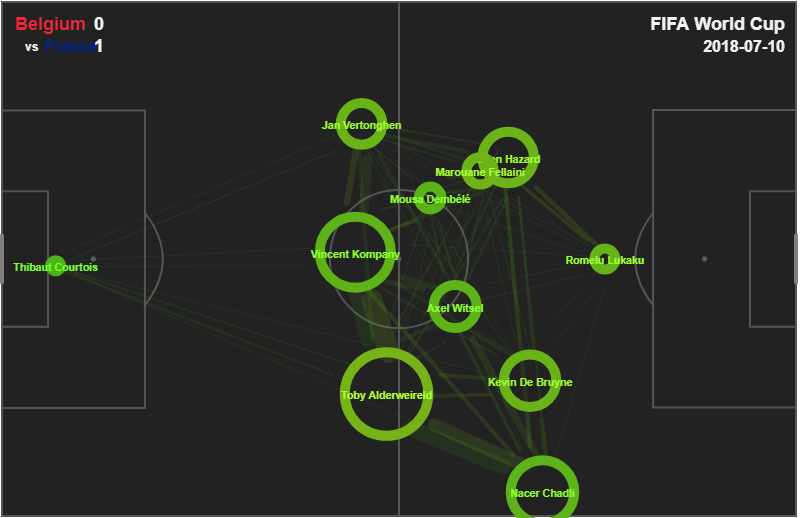The defining force of the 2018 World Cup has been France’s defense. They’ve conceded four goals in the entire tournament. Didier Deschamps has built a team that is devilishly difficult to break down, an immovable object that Croatia will have to pry apart if they want to stage a historic upset.
Those four measly goals came in only two matches. France gave up one to Australia in their opening match, before switching to a lineup which included Blaise Matuidi playing in the attacking band of three to bring defensive stability. Other than that, the only goals France conceded were against Argentina in their wild 4-3 round of 16 victory.
Unsurprisingly France’s underlying defensive numbers are stellar. Only Uruguay, who France soundly dispatched in the quarterfinals, conceded fewer expected goals per 90 minutes than France’s 0.47 over the course of the tournament. Similarly Uruguay was the only team that conceded a lower xG/shot rate at 0.04 to France’s 0.05. Only three teams, Australia and Senegal who didn’t advance from the group stage, and Spain gave up fewer shots. The combination of giving up very few shots and having those shots be of low xG value is the holy grail of defending. France achieved it.
France’s strong defense means that even though their somewhat meager attack has a tendency to greatly undersell its talent, the team still regularly generates more and better scoring opportunities of all types than their opponents.

The question of how France execute their defense is an interesting one. This is neither a typical modern defense, ball dominant and full of intense high pressing to win the ball back quickly nor a traditional deep block. They don’t sit back and absorb pressure. Instead they operate firmly between those two extremes.
Where France pressure teams is highly dependent on their personnel. On the left Blaise Matuidi’s presence in the attacking band means he often is challenging opponents in their own half of the field. On the right, where Kylian Mbappe is often pushed very high in the attack, France contain attacks, forcing them out wide before pressuring them as they advance.

It’s also important to understand that France’s defensive activity in the middle of the pitch is relatively light, not because they are vulnerable, but because they are so impenetrable the ball rarely makes it that far. Their dominance and solidity actually frees up defensive midfield superstar N’Golo Kante to go win the ball all over the pitch. Looking at defensive actions where the ball changes possession, it’s clear that Kante gets to have the freedom to go take the ball from opponents wherever he finds them vulnerable. It’s a clear example both of how stellar he is at getting to the right place to cause damage, and how good France are at letting him do just that.

Nobody has quite figured out how to get the best of France’s approach at this World Cup. In the semifinals Belgium, perhaps the best attacking team of the tournament were simply stopped cold.

That shot map has a whole lot of nothing on it. France were happy to let Belgium filter the ball out to the right where their defense was more than well equipped to deal with the challenges presented by Nacer Chadli.

Eden Hazard was both much more dangerous and much less able to get on the ball during the course of the match. But, ultimately, even his unstoppable dribbling on the ball didn’t do enough to pull France out of their shape and create real opportunities either for himself or for his teammates.
This will be the major problem for Croatia when it comes to the World Cup final. On the one hand, they have the midfielders who could in theory be equipped to break down France. If anybody is going to break through this fortress a combination of Luka Modric, Ivan Rakitic, and Marcelo Brozovic would be that trio. On the other, the way Croatia wants to attack is by using those players to filter the ball out wide.
Croatia’s best moments all involve Modric and Rakitic drifting wide to combine with wingers and fullbacks in order to facilitate attacks down the flanks. That approach has provided just enough juice to get the job done to this point, but they also haven’t had to overcome a defense like France’s. Meanwhile, France just handled a Belgium setup where Eden Hazard was one of the wide men on the ball tasked with unsettling a defense. Croatia’s Ivan Persisic is very good winger, and Ante Rebic has his moments, but neither of them can do anything close to what Eden Hazard can on the ball. And France handled Hazard.
The other thing that France’s slightly lopsided defensive structure does is free up Kylian Mbappe in attack. Because he doesn’t have to defend like Matuidi does, he can stay higher up the pitch and combine with Antoine Griezmann and Olivier Giroud on the counter. In Croatia’s semifinal against England, they looked their most vulnerable when England was able to get the ball forward to Raheem Sterling quickly and get him isolated against a central defender. If France can similarly isolate Mbappe then Croatia will likely be in for a long day.
Coming into the tournament the lack of a cohesive attack out of France was the main story. The way the side seemingly squandered, dynamic attacking talent overshadowed just how defensively strong they’re set up to be. As France head to the finals, the defense deserves all the attention it’s getting. Kante is every bit the superstar that his more glamorous teammates are, the beating heart at the center of a defense that has completely owned this tournament. Defense can be harder to appreciate than attack, but it’s no less important. And France have the best defender in the world in their midfield. And they’ve shown him off all tournament long.